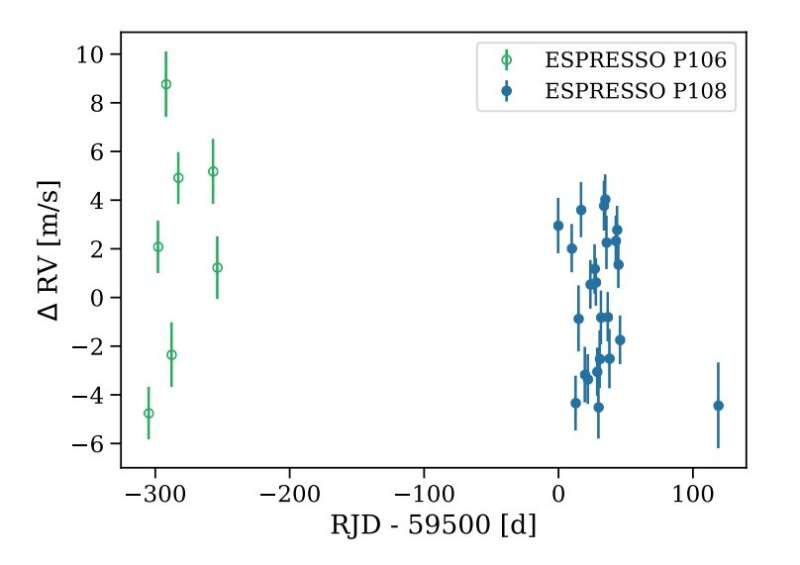November 1, 2022 report
New exoplanet detected with the ESPRESSO spectrograph

Using the Echelle SPectrograph for Rocky Exoplanets and Stable Spectroscopic Observations (ESPRESSO), astronomers from Switzerland and Austria have discovered a new alien world. The newfound exoplanet orbits a nearby M dwarf star and is at least four times more massive than the Earth. The finding is reported in a paper published October 23 on arXiv.org.
ESPRESSO is the state-of-the-art ultra-stable high resolution spectrograph installed at the Very Large Telescope (VLT) in Chile, covering the spectral range from about 380 nm to 788 nm. The instrument is able to reach a precision allowing it to detect Earth-like planets around sun-like stars.
A team of astronomers led by Lia F. Sartori of the Swiss Federal Institute of Technology in Zürich, Switzerland, is conducting a blind ESPRESSO radial velocity search for planets around nearby stars. One of their targets was L 363-38—an M dwarf located some 33.3 light years away. They monitored this star between December 12, 2020 and February 08, 2022, obtaining a total of 31 observations, which resulted in the detection of a new planet.
"In the following we report the detection and characterization of a planet orbiting the nearby M dwarf star L 363-38. This is one of the few standalone planet discoveries with ESPRESSO so far," the researchers wrote in the paper.
The newly detected planet, designated L 363-38 b, has a minimum mass of about 4.67 Earth masses and its radius is estimated to be between 1.55 and 2.75 Earth radii. The exoplanet orbits its host every 8.78 days, at a distance of some 0.048 AU from it, therefore inside the inner edge of the habitable zone. The equilibrium temperature of L 363-38 b was calculated to be approximately 330 K.
The parent star L 363-38 (other designations: LHS 1134 and GJ 3049), estimated to be 8 billion years old, has a radius of about 0.274 solar radii and a mass of around 0.21 solar masses. The effective temperature of this star was measured to be 3129 K.
The astronomers suppose that L 363-38 may be orbited by some other planets that remain undetected. They explain that based on statistics from NASA's Kepler and TESS missions, planets around M dwarfs are expected to occur in multi-planet systems. Hence, follow-up observations of this planetary system with telescopes such as the James Webb Space Telescope (JWST), are required in order to uncover the presence of other extrasolar worlds around L 363-38.
In concluding remarks, the authors of the study demonstrates the potential of ESPRESSO in detecting and investigating exoplanets around nearby M dwarf stars.
"Indeed, the faintness of M stars makes them challenging targets for RV [radial velocity] studies using instruments like HARPS [High Accuracy Radial velocity Planet Searcher] behind a 3.6-m telescope, but a spectrograph behind an 8-m telescope like ESPRESSO can gather sufficient light to precisely measure their RV in an efficient manner," the researchers concluded.
More information: Lia F. Sartori et al, L 363-38 b: a planet newly discovered with ESPRESSO orbiting a nearby M dwarf star, arXiv (2022). DOI: 10.48550/arxiv.2210.12710
Journal information: arXiv
© 2022 Science X Network




















